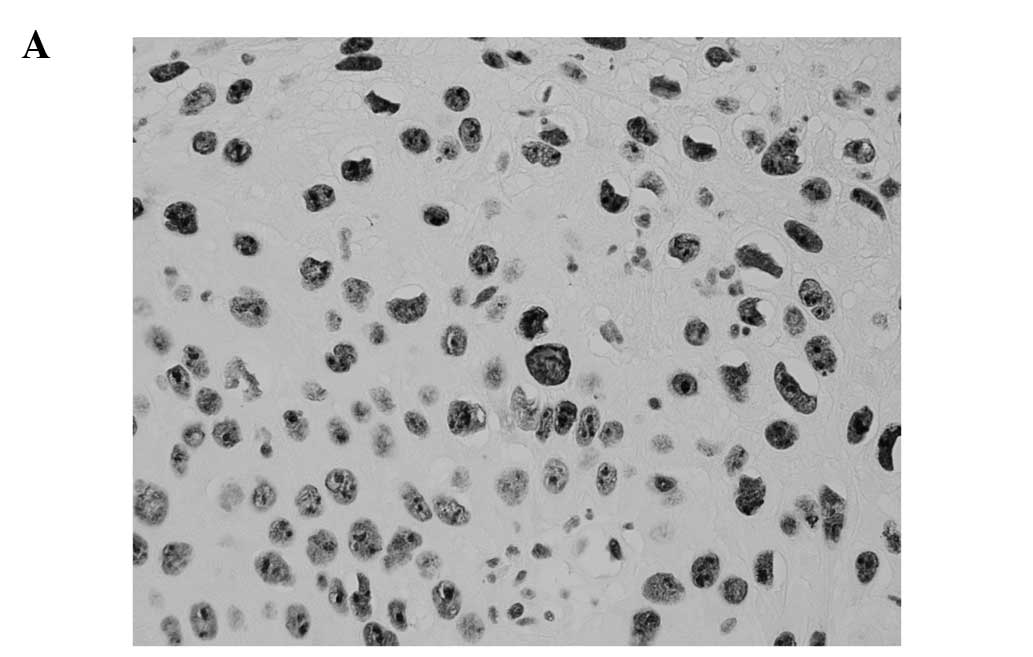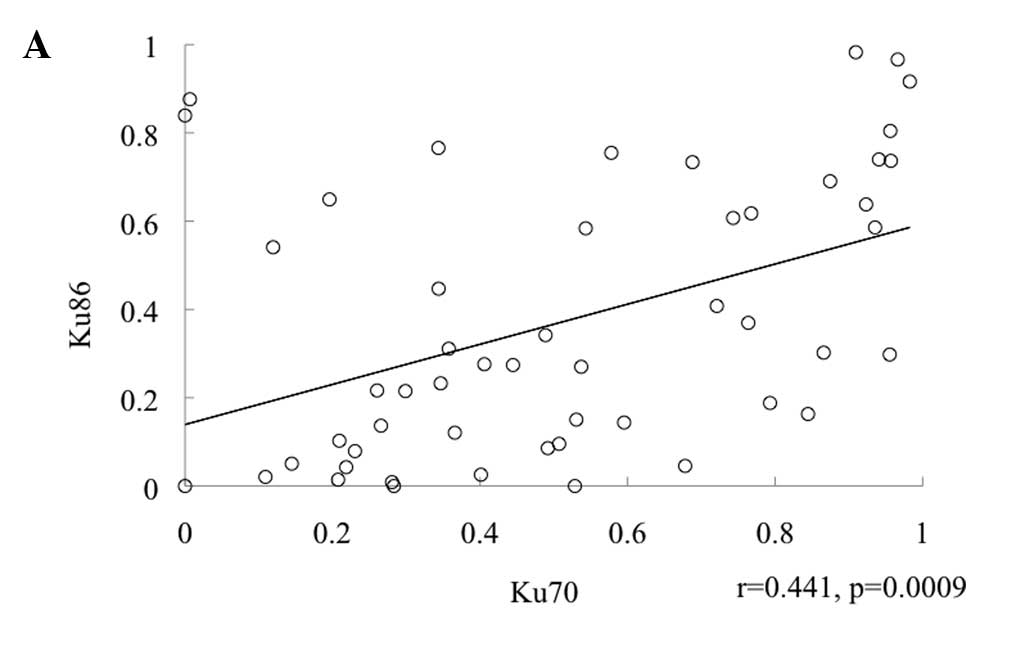|
1
|
Adelstein DJ, Li Y, Adams GL, et al: An
intergroup study phase III comparison of standard radiation therapy
and two schedules of concurrent chemoradiotherapy in patients with
unresectable squamous cell head and neck cancer. J Clin Oncol.
21:92–98. 2003. View Article : Google Scholar
|
|
2
|
Denis F, Garaud P, Bardet E, et al: Final
results of the 94-01 French Head and Neck Oncology and Radiotherapy
Group randomized trial comparing radiotherapy alone with
concomitant radiochemotherapy in advanced-stage oropharynx
carcinoma. J Clin Oncol. 22:69–76. 2004. View Article : Google Scholar
|
|
3
|
Forastiere AA, Goepfert H, Maor M, et al:
Concurrent chemotherapy and radiotherapy for organ preservation in
advanced laryngeal cancer. N Engl J Med. 349:2091–2098. 2003.
View Article : Google Scholar : PubMed/NCBI
|
|
4
|
Hall EJ: DNA strand breaks and chromosomal
aberrations. Radiobiology for the Radiologist. Hall EJ and Giaccia
AM: 6th edition. Lippincott Williams & Wilkins; Philadelphia:
pp. 16–29. 2006
|
|
5
|
Polo SE and Jackson SP: Dynamics of DNA
damage response proteins at DNA breaks: a focus on protein
modification. Gene Dev. 25:409–433. 2011. View Article : Google Scholar : PubMed/NCBI
|
|
6
|
Lees-Miller SP: The DNA-dependent protein
kinase, DNA-PK: 10 years and no ends in sight. Biochem Cell Biol.
74:503–512. 1996.PubMed/NCBI
|
|
7
|
Jeggo PA: Identification of genes involved
in repair of DNA double-strand breaks in mammalian cells. Radiat
Res. 150:S80–S91. 1998. View
Article : Google Scholar : PubMed/NCBI
|
|
8
|
Komuro Y, Watanabe T, Hosoi Y, et al: The
expression pattern of Ku correlates with tumor radiosensitivity and
disease free survival in patients with rectal carcinoma. Cancer.
95:1199–1205. 2002. View Article : Google Scholar : PubMed/NCBI
|
|
9
|
Zhao HJ, Hosoi Y, Miyachi H, et al:
DNA-dependent protein kinase activity correlates with Ku70
expression and radiation sensitivity in esophageal cancer cell
lines. Clin Cancer Res. 6:1073–1078. 2000.PubMed/NCBI
|
|
10
|
Sakata K, Matsumoto Y, Tauchi H, et al:
Expression of genes involved in repair of DNA double-strand breaks
in normal and tumor tissues. Int J Radiat Oncol Biol Phys.
49:161–167. 2001. View Article : Google Scholar : PubMed/NCBI
|
|
11
|
Kamdar RP and Matsumoto Y:
Radiation-induced XRCC4 association with chromatin DNA analyzed by
biochemical fractionation. J Radiat Res. 51:303–313. 2010.
View Article : Google Scholar : PubMed/NCBI
|
|
12
|
Sakata K, Someya M, Nagakura H, et al:
Brachytherapy for oral tongue cancer: an analysis of treatment
results with various biological markers. Jpn J Clin Oncol.
38:402–407. 2008. View Article : Google Scholar : PubMed/NCBI
|
|
13
|
Pointreau Y, Garaud P, Chapet S, et al:
Randomized trial of induction chemotherapy with cisplatin and
5-fluorouracil with or without docetaxel for larynx preservation. J
Natl Cancer Inst. 101:498–506. 2009. View Article : Google Scholar
|
|
14
|
Posner MR, Hershock DM, Blajman CR, et al:
Cisplatin and fluorouracil alone or with docetaxel in head and neck
cancer. New Engl J Med. 25:1705–1715. 2007. View Article : Google Scholar : PubMed/NCBI
|
|
15
|
Someya M, Sakata K, Matsumoto Y, Satoh M,
Narimatsu H and Hareyama M: Immunohistochemical analysis of Ku70/86
expression of breast cancer tissues. Oncol Rep. 18:1483–1487.
2007.PubMed/NCBI
|
|
16
|
Hosoi Y, Watanabe T, Nakagawa K, et al:
Up-regulation of DNA-dependent protein kinase activity and Sp1 in
colorectal cancer. Int J Oncol. 25:461–468. 2004.PubMed/NCBI
|
|
17
|
Raybaud-Diogene H, Fortin A, Morency R,
Roy J, Monteil RA and Tetu B: Markers of radioresistance in
squamous cell carcinomas of the head and neck: a clinicopathologic
and immunohistochemical study. J Clin Oncol. 15:1030–1038.
1997.PubMed/NCBI
|
|
18
|
Okuno Y, Nishimura Y, Kashu I, Ono K and
Hiraoka M: Prognostic values of proliferating cell nuclear antigen
(PCNA) and Ki-67 for radiotherapy of oesophageal squamous cell
carcinomas. Br J Cancer. 80:387–395. 1999. View Article : Google Scholar : PubMed/NCBI
|
|
19
|
Nakano T and Oka K: Differential values of
Ki-67 index and mitotic index of proliferating cell population. An
assessment of cell cycle and prognosis in radiation therapy for
cervical cancer. Cancer. 72:2401–2408. 1993. View Article : Google Scholar : PubMed/NCBI
|
|
20
|
Burma S, Chen BPC and Chen DJ: Role of
non-homologous end joining (NHEJ) in maintaining genomic integrity.
DNA Repair. 5:1042–1048. 2006. View Article : Google Scholar : PubMed/NCBI
|
|
21
|
Someya M, Sakata K, Matsumoto Y, et al:
The association of DNA-dependent protein kinase activity with
chromosomal instability and risk of cancer. Carcinogenesis.
27:117–122. 2006. View Article : Google Scholar : PubMed/NCBI
|













